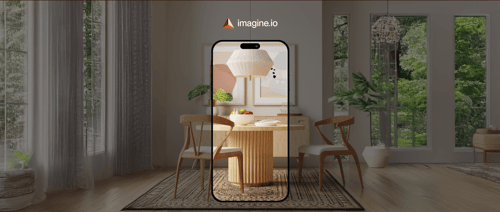The eCommerce landscape is a visual battlefield. Every click, every scroll, every sale hinges on stunning, versatile product imagery that captures attention and drives conversions. For furniture, home décor, and textile brands, the pressure to deliver photorealistic visuals across sprawling catalogs is relentless. Traditional agencies, once the gold standard for product photography and CGI, are buckling under the demands of speed, scale, and cost-efficiency. Now, a new wave of platform-led CGI solutions, like those from imagine.io, is empowering brands to take control, slashing costs by up to 70% and boosting conversions by over 500%. This isn't just a trend it's a revolution in how brands create and manage their visual assets.
A Shift in the Visual Content Creation Landscape
The explosion of eCommerce has redefined what brands need from their visuals. Online shoppers expect more than a static image; they want 360 spins, augmented reality previews, and customizable product views, all tailored to their preferences. For industries like furniture and home décor, where a single product might require dozens of variations different fabrics, finishes, or settings the challenge is immense. A 2023 report from Future Data Stats projects the global Computer-Generated Imagery market to grow from $18.70 billion to $48.30 billion by 2030, with a steady CAGR of 8.3%. This growth underscores the critical role of digital visuals in industries from advertising to product design.
Agencies, however, are hitting a wall. Their reliance on manual processes, physical shoots, and fragmented workflows makes them slow and expensive. Coordinating with multiple vendors for images, videos, or interactive features often leads to delays and inconsistent branding. Brands in cities like New York, Los Angeles, and High Point are feeling the pinch, pushing them to seek solutions that offer both quality and agility. Platform-led CGI is stepping into that gap, delivering tools that let brands manage their own visual pipelines with unprecedented control.
Emerging Trends Driving Platform-Led CGI Adoption
Cloud-Powered Real-Time Rendering
Speed is the name of the game. Platforms like imagine.io use cloud-based rendering to transform 3D models into photorealistic assets in minutes, not weeks. This eliminates the long lead times of traditional agency workflows, allowing brands to keep pace with fast-moving eCommerce demands. Whether it's a new product launch or a seasonal campaign, real-time rendering ensures visuals are ready when the market demands them.
All-in-One Visual Platforms
Unlike agencies that focus narrowly on one type of output say, product photography or video modern platforms integrate a full suite of tools. Imagine.io, for example, offers 3D images, videos, 360 spins, AR experiences, and product configurators, all within a single ecosystem. This all-in-one approach streamlines workflows, reduces vendor juggling, and ensures consistent quality across channels like Instagram, LinkedIn, and YouTube.
AI-Enhanced Creative Efficiency
Artificial intelligence is turbocharging these platforms. By automating repetitive tasks like lighting adjustments or background staging, AI frees creative teams to focus on strategy and innovation. Imagine.io's platform, for instance, produces visuals so lifelike that eCommerce experts can't distinguish them from traditional photoshoots. This blend of automation and quality is reshaping how brands approach visual content creation.
Real-World Applications and Success Stories
Scaling Across Product Variations
Picture a furniture brand rolling out a new line of sofas. With hundreds of fabric options and configurations, producing visuals the old way could take months. Using imagine.io, the same brand can upload a 3D model and generate thousands of photorealistic variations in hours. This scalability is a lifeline for companies like Ruggable or Kichler, who need to showcase diverse catalogs to customers in markets like Austin, Chicago, and Dallas.
Lifestyle and Contextual Imagery on Demand
Gone are the days of expensive location shoots. CGI platforms allow brands to stage products in virtual settings a cozy living room, a sleek office without ever leaving the studio. This flexibility saves time and money while delivering visuals that resonate with consumers. A textile brand, for instance, can showcase fabrics in real-world contexts, enhancing storytelling and customer engagement.
Interactive Shopping Experiences
Interactive features like product configurators and AR viewers are redefining online shopping. Customers can customize a chair's upholstery or visualize a lamp in their home, driving engagement and boosting conversions by over 500%, according to imagine.io's metrics. These tools are especially impactful in competitive regions like the United States and Canada, where brands are vying for attention in crowded digital marketplaces.
Key Challenges in Transitioning to Platforms
Learning Curve and Workflow Integration
Moving to a platform-led model isn't seamless. Creative teams used to agency hand-holding may need time to adapt to a self-service SaaS environment. Training and onboarding are critical to ensure smooth integration, especially for brands with complex workflows. Imagine.io addresses this with intuitive interfaces, but the transition still requires commitment.
Subscription vs. Project-Based Budgeting
Some brands balk at ongoing subscription costs, especially when they're accustomed to one-off agency fees. Imagine.io's custom pricing, tailored to each client's needs, can feel intricate compared to competitor's simpler models. Yet, the long-term savings up to 70% on production costs often outweigh these concerns, particularly for brands with high-volume catalogs.
Breaking From Established Agency Relationships
Many brands, especially in procurement-heavy markets like Las Vegas or Chicago, rely on pre-approved agency pools. Switching to a platform like imagine.io requires navigating internal resistance and re-evaluating vendor relationships. While challenging, the shift promises greater independence and efficiency, making it a worthwhile leap.
Opportunities and Business Impact
Cost Savings at Scale
Platforms like imagine.io are a financial game-changer. By automating asset creation and eliminating physical shoots, brands can slash production costs by up to 70%. This is critical for companies managing tight margins or expansive catalogs, allowing them to reinvest savings into innovation or marketing.
Creative Agility
Rapid prototyping is another boon. Platforms enable brands to test and refine designs quickly, accelerating time-to-market. A home décor brand can iterate on a new lamp design and have visuals ready for launch in days, not weeks, giving them a competitive edge in fast-paced markets.
Brand Consistency Across Channels
Centralized platforms ensure visuals are uniform across websites, social media, and marketplaces. This consistency strengthens brand identity, whether a customer is browsing on Kohler's site or scrolling through Instagram. The Business Research Insights report highlights the CGI market's growth from $7.73 billion in 2024 to a projected $32.92 billion by 2033, driven by AI and machine learning advancements that enhance rendering speed and realism.
Expert Insights and Future Outlook
Platform-First as the New Standard
The future is clear: platform-led CGI will dominate. As technology evolves, brands will increasingly favor in-house control over outsourced workflows. The LinkedIn Pulse report notes the CGI services market, valued at $18.2 billion in 2023, is expected to grow at a CAGR of 11.4% through 2030, fueled by demand for high-quality visuals and sustainable practices.
Hybrid Models on the Horizon
Agencies won't vanish entirely. A hybrid model may emerge, with agencies focusing on bespoke creative projects while platforms handle scalable production. This balance could redefine partnerships, blending strategic vision with operational efficiency.
The Edge of Early Adoption
Brands adopting platforms now are setting the pace. By leveraging tools like imagine.io, they're not just keeping up they're defining the visual standards of tomorrow, responding swiftly to trends, and outpacing competitors mired in outdated processes.
A Memorable Conclusion
The rise of platform-led CGI marks a pivotal shift for brands navigating the eCommerce frontier. With tools like imagine.io, companies can achieve photorealistic quality, unmatched speed, and scalable production all while retaining creative control. The numbers speak for themselves: up to 70% cost savings, 500% conversion boosts, and a market poised for explosive growth. For furniture, home décor, and textile brands ready to break free from agency constraints, the choice is clear: embrace the platform revolution and redefine what's possible. The future of visual content isn't just bright it's already here, rendering pixel by pixel.
Frequently Asked Questions
What is platform-led CGI and how does it differ from traditional agency CGI services?
Platform-led CGI refers to self-service software platforms that allow brands to create photorealistic 3D visuals, videos, and interactive experiences in-house, rather than outsourcing to traditional agencies. Unlike agencies that rely on manual processes and physical shoots, platforms like imagine.io use cloud-based real-time rendering and AI automation to produce visuals in minutes instead of weeks. This approach gives brands direct control over their visual content creation while eliminating the coordination delays and inconsistent results often associated with agency workflows.
How much can brands save by switching from agencies to CGI platforms?
Brands can achieve up to 70% cost savings by switching from traditional agencies to platform-led CGI solutions. These savings come from eliminating expensive physical photoshoots, reducing vendor coordination costs, and automating repetitive tasks through AI. Additionally, platforms report conversion rate improvements of over 500% due to enhanced interactive features like product configurators and AR experiences. The long-term subscription model, while initially different from project-based agency fees, delivers significant ROI for brands with high-volume catalogs.
What challenges do brands face when transitioning from agencies to CGI platforms?
The main challenges include overcoming the learning curve as creative teams adapt from agency hand-holding to self-service platforms, adjusting budgets from project-based to subscription models, and navigating internal resistance when breaking established agency relationships. Brands in procurement-heavy markets may need to re-evaluate vendor approval processes. However, most platforms address these concerns through intuitive interfaces, comprehensive training, and custom pricing options tailored to each client's specific needs and workflow requirements.
Disclaimer: The above helpful resources content contains personal opinions and experiences. The information provided is for general knowledge and does not constitute professional advice.
You may also be interested in: Partnerships – Imagine.io
Struggling with expensive, outdated product visuals that slow down your creative process and stunt eCommerce growth? imagine.io's AI-powered platform empowers furniture, home décor, and textile brands to effortlessly produce striking 3D images, immersive videos, AR experiences, and interactive configurators. Cut production costs up to 70%, boost conversions 5X, speed up prototyping, and supercharge your online sales. Ready to elevate your product visuals and captivate customers? Book a demo with imagine.io today!
Powered by flareAI.co




.png?width=500&name=How%20to%20Add%20a%203D%20Product%20Configurator%20to%20Your%20WordPress%20Website%20(Complete%20B2B%20Guide).png)
















%20(1).png?width=500&name=Why%20Exploded%20Mattress%20Views%20Matter%20(And%20How%20to%20Generate%20Them)%20(1).png)
.png?width=500&name=Best%20Shopify%20Product%20Configurator_%20How%20to%20Choose%20the%20Right%20One%20(2).png)
.png?width=500&name=Why%20Exploded%20Mattress%20Views%20Matter%20(And%20How%20to%20Generate%20Them).png)



.png?width=500&name=Best%20Shopify%20Product%20Configurator_%20How%20to%20Choose%20the%20Right%20One%20(1).png)







.png?width=500&name=How%203D%20Rendering%20Can%20Make%20or%20Break%20Your%20Industrial%20Design%20Pitch%20(1).png)








%20with%20Digital%20Twins%20and%203D%20Visualization.png?width=500&name=Optimizing%20Your%20Digital%20Asset%20Management%20(DAM)%20with%20Digital%20Twins%20and%203D%20Visualization.png)




.png?width=500&name=Styling%20Home%20Decor%20for%202025_%20From%20Global%20Influences%20to%20Playful%20Personalization%20(1).png)
